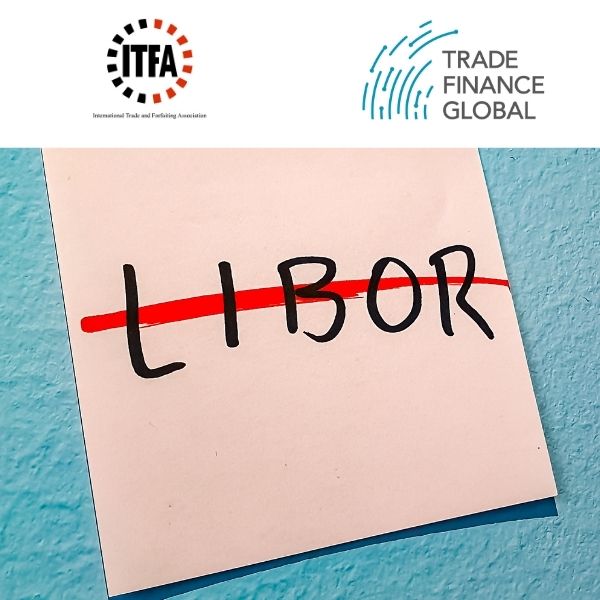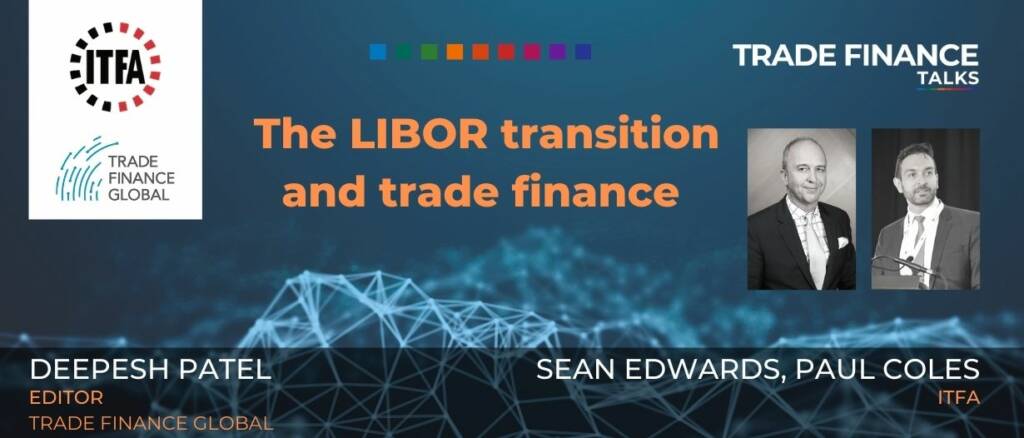Last week, at the International Trade and Forfaiting Association (ITFA) Annual Conference, TFG’s editor, Deepesh Patel, sat down with Sean Edwards, chairman of ITFA.
They discussed how trade finance has changed – or not changed – during the COVID-19 pandemic, and how the industry can build on its pandemic learnings going forward.
Global trade volumes vs trade finance lending levels
Despite global trade volumes having almost rebounded to pre-pandemic levels, one of the biggest stories of the pandemic is that trade finance lending hasn’t bounced back in the same way, and is in fact lagging behind quite significantly.
In 2020, the total volume of global trade dropped about 10%, but the total volume of trade finance dropped a lot more – all the way to 2016-17 levels.
“I think it’s partly the nervousness of the banks, and that it’s different across different products,” said Edwards.
“As we expected, supply chain finance actually ramped up quite a lot, and I know that from my own experience at SMBC [Sumitomo Mitsui Banking Corporation].”
According to Edwards, banks continue to be cautious in 2020 and 2021, and were waiting to see if there were many casualties of the pandemic – an outcome that massive government support was able to offset.
“Banks did hold back, and they funded key customers, but not the full range of customers,” said Edwards.
”And obviously that lag, and that shortfall for those other customers is affecting the figures. But it’s getting back to where it was pretty quickly.”
Supply chain finance – A tarnished reputation?
Among the parties that Edwards considers unscathed from the pandemic is supply chain finance.
Edwards said supply chain finance has not been impacted by the pandemic, and most certainly hasn’t had its reputation tarnished through its response, despite the collapse of Greensill Capital.
“Speaking from personal experience, the bit of Greensill that actually was proper supply chain finance performed very well, as it should,” said Edwards.
“And the drop in funding, and the potential vacuum due to the withdrawal of Greensill, was actually filled very quickly by the banks and other platforms.
Edwards added that supply chain finance has also come out unscathed following several UK parliamentary committee inquiries into the Greensill collapse, which concluded that there is no need to further regulate supply chain finance.
“Remember that banks themselves, of course, are regulated as suppliers separately,” said Edwards. “But there was no need to regulate the product anymore, so that’s good.
“There was also a big vote of confidence in trade credit insurance, which underpinned some of the Greensill portfolio and got caught up in the mud – that’s performed well too.”

The LIBOR transition for trade finance
Asked if bankers are pulling their hair out over the LIBOR transition in trade finance, Edwards said it is undoubtedly a huge and expensive project, but it is no longer the existential threat it was once considered to be.
“We’re now in a position where we’ve got the right replacements for LIBOR, so the LIBOR transition is a much smaller deal than I think many people thought it would be,” said Edwards,
On the topic of LIBOR, Edwards also referenced the ‘LIBOR Transition for Trade Finance Hub’ – a collaboration with ITFA and TFG.
“For our members, we are also about to publish some amendments and agreements to deal with the transition from an MRPA perspective,” said Edwards.
Trade digitisation – Did we digitise trade during the COVID-19 pandemic?
Across industries, the COVID-19 pandemic has been hailed as a catalyst for new digital solutions, in areas where paper and analogue once prevailed.
On this note, Edwards was less sanguine.
Although the pandemic has led to more widespread use of technologies like electronic signatures – such as DocuSign – Edwards said this doesn’t necessarily amount to a ‘digitisation of trade’.
“There’s certainly an increased focus on proper digitisation, by which I mean platformisation and digitisation of trade documents – something that’s been a big theme of this conference,” said Edwards.
“But we didn’t achieve that in 2020, nor was there substantially more investment in it.”
Among the reasons for the funding gap, Edwards explained, is that smaller banks are still waiting on the sidelines to invest.
“It’s an expensive proposition, and there are a lot of legacy systems in it,” said Edwards.
“The important thing is though, that digitalisation is on the agenda, and it will probably happen a little bit sooner, but it didn’t happen in 2020.”
ESG and sustainability
Lastly, Edwards was asked about the possibility that the trade finance industry is simply ‘green-washing’ in response to greater calls for action on climate change.
Far from it, as Edwards explained, the problem lies not in green-washing itself, but in the paradox of choice that trade finance companies are now faced with in terms of ways to go green.
“I think we’re at the ‘light green stage,” said Edwards. “So we’re not fully green, and I think part of the reason for that is: When there is so much to choose from, how do you go green?
“Do you use the UN [United Nations] Sustainable Development Goals? Are you trying to comply with the EU Taxonomy, or the UK Taxonomy we’re about to have?”
Another hurdle is disclosure agreements, which are a kind of private standard applied to sustainable or ‘ESG’ loans, and which vary from one lender to another.
“One doesn’t really know where to turn, and one doesn’t know what it means to be green yet,” said Edwards.
“At ITFA we’ve set up an ESG committee to help us navigate our way through that jungle, but again, it’s like digitisation: it’s definitely happening, it’s definitely on the agenda, and it’s definitely going to stay on the agenda.
“So I don’t think it’s green-washing, but it’s a lighter shade of green for the moment.”
Learn more about the LIBOR transition by visiting ITFA / TFG’s LIBOR hub

 Australia
Australia Hong Kong
Hong Kong Japan
Japan Singapore
Singapore United Arab Emirates
United Arab Emirates United States
United States France
France Germany
Germany Ireland
Ireland Netherlands
Netherlands United Kingdom
United Kingdom














Comments are closed.